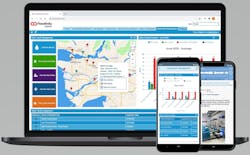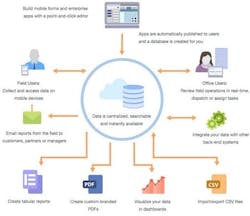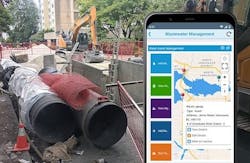About the author:
Sean King is marketing communications specialist for Flowfinity. King can be reached at [email protected].
Management teams at water and waste utilities are finding that a reliance on processes driven by paper forms, spreadsheets, and legacy systems is hindering operations and impeding growth.
Operations and IT departments are being asked to do more with less. Tightening budgets mean smart, effective investments are needed to reduce costs and achieve long-term efficiencies. Meanwhile aging infrastructure, increasing demand and new regulatory requirements are pressing utility managers into facing the difficult tasks of modernizing infrastructure and digitizing operations at the same time.
Tech-savvy managers understand that building a comprehensive water data management solution can help achieve these goals by streamlining operations, improving efficiency and boosting long-term asset performance. A flexible and integrated data management system will also help water utilities become more data-driven by centralizing enterprise data into one unified system, empowering teams to visualize and analyze operations in real-time.
An abundance of new technologies has come to market in recent years, enabling operations departments to lead digital transformation efforts and bring data-driven decision making into the heart of the organization. It is now possible to easily create, automate and integrate specialized water utility management applications that will streamline processes and boost productivity without having to write and maintain custom code.
Based on the successful digitalization projects of water utilities, below are some key considerations every utility manager should make when looking for a custom workflow and data management system.
Digitize Data Collection & Validation with Custom Apps
Whether in the lab, field or facility, accurate data collection is essential. Digitizing data capture is the crucial first step in transforming operations and offers immediate efficiency gains. Most organizations now understand the need to replace paper forms and spreadsheets, as manual data entry can cause errors, delays and bottlenecks. Off-the-shelf water data management solutions often lack the flexibility to meet unique needs and are difficult to integrate with core systems. As a result, forward-thinking water utilities professionals are now creating their own custom data collection apps using no-code tools.
Advances in no-code app configuration platforms make them ideal for creating process-specific data collection solutions. Entry forms can be quickly created using a variety of pre-configured field types, and existing forms can be easily amended when business processes or regulatory requirements change, which in turn help to reduce development costs and delays.
Essential functionality to look for in a data collection application include:
- High-precision GPS;
- Photo, audio and document upload;
- Offline capabilities;
- Custom validation rules; and
- Formulas and on-device calculations.
In addition to streamlining data capture, effective process management applications allow you to build business logic into forms that drive workflow. If an asset is identified as requiring maintenance, additional information needs to be gathered, and this logic is built into the form. Digital data collection provides a better user experience for technicians while ensuring data is accurate at the source by reducing the chance of entry errors or omissions.
Control Data Access With a Centralized Database
Digitizing data collection is a critical step in becoming a more efficient organization. However, to truly replace and improve upon processes based on paper or spreadsheets, utilities also need to invest in effective data management.
A central relational database offers two key benefits; firstly, data is available in real-time to anyone who needs it at any time, from any connected device. This reduces delays, allowing you and your staff to analyze a situation and make an informed decision quickly.
Secondly, the ability to view or enter data is two-way, whether on site or in the office. Field users can send records to the database and access existing submitted records in real-time. SQL database-driven applications also ensure data integrity by reducing the opportunity for data to become lost or duplicated, which occurs when data is siloed in disparate systems or spreadsheets.
Integrate a Unified Data Management System
Significant productivity gains can be achieved by integrating data collection and management applications with SCADA, CRM, and ERP software. This gives utilities unprecedented insight into their operations, with both real-time and historical data available in one unified system.
For example, many utilities use GIS software to perform data analysis. However, without reliable integrations, data must be manually transitioned between systems, risking valuable data becoming siloed, duplicated or corrupted, not to mention the cost in time and effort.
Integration allows two-way synchronization between a central database and specialist software used by technicians, operators, and other specialists. By using APIs to connect core applications into a unified system, delays and errors associated with manual data entry are reduced while opportunities are created for data visualizations and process automations.
Improve Reporting & Analytics With Interactive Dashboards
Once core software is integrated, dashboards can be configured to improve the quality of both historical and real-time data analysis. Interactive dashboards go beyond mere visualization in charts, tables and maps. They are fully customizable and allow users to act on operational data in real-time. Any key performance indicators that need to be tracked can be intuitively displayed, and if something requires action, an operation can be launched with a click.
Utility managers can use dashboards to oversee their operations, such as field crew and operator performance, and to help visualize and monitor supervisory systems. Dashboards can also act as a central hub and application interface to assign work orders and review the progress of projects and tasks.
Advanced interactive dashboards feature built-in mapping capabilities and high precision GPS capability to greatly improve the efficiency of maintenance and inspection crews. Dashboards can now also host basemaps from popular GIS providers to allow utilities to render and view custom map styles tied to structured data from their central database.
Reimagine Core Processes & Automate Workflows
Often utilities can settle into workflows that are no longer ideal, or worse, they are unable to re-engineer core operational processes due to the rigidity of legacy systems and outdated software.
This can be solved by adopting a flexible core business system that allows managers to update and reconfigure workflow functionality at will. No-code application configuration platforms allow you to easily update workflows as needs evolve, such as using software robots to automate routine data processing tasks and escalations.
Ultimately, the most efficient way to run water utility operations is to embrace a core system that can manage large volumes of data and automate routine workflows so that staff is empowered to make better decisions.
In our customers’ experience, common workflow automation use cases include:
- Field crew and facility management;
- Sampling management;
- Proactive and reactive maintenance;
- Compliance and safety management and reporting;
- SCADA management and alarm procedures; and
- Industrial Internet of Things (IIoT) integration.
Design an Asset Management Hub
The rehabilitation and renewal of equipment and infrastructure represent a major challenge to utilities. It is essential to develop an effective asset management plan as spiraling maintenance costs can quickly consume available operating budgets.
Effective asset management plans transition organizations from reactive to proactive and facilitate predictive maintenance and efficient capital planning. However, to do this requires organizations to effectively manage and analyze both real-time and historic data for accurate predictions.
A custom data management solution allows managers to connect asset management workflows to maintenance and other workflows easily while breaking down information silos. By combining digital data collection, custom workflow automations, centralized databases and integrations with GIS solutions and specialist software, it is possible to use no-code tools and app templates to configure an asset management system that meets the needs of any utility.



